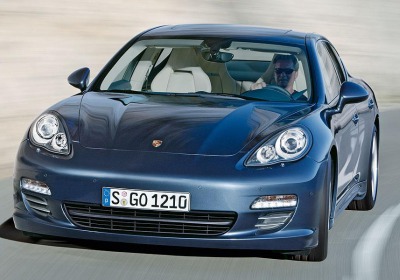Porsche Panamera explained in greater detail
Mon, 16 Mar 2009
Porsche has revealed previously undisclosed details of its new Panamera ahead of a planned public debut at next month's Shanghai motor show.
On sale in North America on Oct. 17, the first-ever Porsche sedan will cost more than the BMW M5 and the Mercedes-Benz CLS63 AMG, with prices starting at $89,800 for the base rear-wheel-drive Panamera S and rising to $93,800 for the four-wheel-drive Panamera 4S. Topping the new lineup will be the extensively equipped four-wheel-drive Panamera Turbo, with a $132,600 price tag that will push it into direct competition with the Maserati Quattroporte GTS and the upcoming Aston Martin Rapide.
Styled by a team of in-house designers under the direction of Porsche design boss Michael Mauer, the Panamera is 195.7 inches long, 76.0 inches wide and 55.8 inches tall--making it slightly shorter but wider and lower than the Quattroporte, with which it shares a distinctly coupelike profile. Unlike the Pininfarina-designed Maserati, however, the new Porsche features a large liftback at the rear, enabling easy access to the trunk.
Focus on cutting weight
The Panamera's body uses a combination of lightweight materials.
Porsche has gone to a lot of trouble with the development of the Panamera's body to reduce weight. Materials used include high-strength steel, aluminum, plastic and magnesium, the latter incorporated into the window frames. It appears to have paid off; the lightest Panamera, the rear-drive S, weighs 3,902 pounds, or about 33 pounds more than the M5 and 132 pounds less than the CLS63 AMG.
Another area where Porsche's Weissach-based engineers have focused is the Panamera's aerodynamics. The base S, which comes with 245/50ZR-18 (front) and 275/45ZR-18 (rear) tires, has a Cd of 0.29 combined. Among the measures taken to reduce lift is a completely flat underbody. The highlight, however, is a radical new rear spoiler which emerges from underneath the backlight and uses motorized arms to extend over the rear wheel arches and increase downforce.
Inside, the Panamera offers accommodations for four adults. The rear seats are individual affairs with tall back rests that can be electronically reclined for added comfort. Nominal trunk capacity is put at 15.7 cubic feet, although Porsche will offer the Panamera with standard individual folding rear seats that trunk capacity increase to 44.7 cubic feet.
Under the skin, the Panamera uses a unique aluminum-intensive chassis for its 115.0-inch wheelbase along with 65.3-inch front and 65.4-inch rear tracks. The front suspension is via double wishbones, while the rear end features a multilink arrangement with the springs and shocks mounted separately to improve packaging.
Two powertrain choices
Transmissions choices are a six-speed manual or the dual-clutch PDK.
Three different levels of stiffness are available by way of active suspension management, which comes standard, as does stability and traction control and dynamic chassis control. Adaptive air springs also are standard on the Panamera Turbo, but they will be optional on the S and the 4S.
The Panamera will be available with the choice of two 4.8-liter V8 direct-injection engines, both now in use in the Cayenne. The S and the 4S models get a naturally aspirated engine rated at 394 hp at 6,500 rpm and 369 lb-ft of torque at 3,500 rpm. In turbocharged form, the four-valve-per-cylinder engine delivers 493 hp at 6,000 rpm and 516 lb-ft of torque at just 2,250 rpm.
Gearboxes include a standard six-speed manual on the S, while the four-wheel-drive 4S and Turbo receive Porsche's newly introduced seven-speed dual-clutch PDK unit--both of which are mated to an automatic stop/start system, a first for Porsche, that reduces fuel consumption by shutting off the engine when the car comes to a stop.
Porsche claims the Panamera is good for 0-to-62-mph times of 5.6 seconds, 5.0 seconds and 4.2 seconds, respectively, for the S, the 4S and the Turbo. The latter also is capable of hitting 100 mph in 9.0 seconds and reaching a top speed of 188 mph.
In a display of just how efficient the new seven-speed PDK dual-clutch gearbox is, the Turbo's combined fuel consumption is claimed to be better than that of the S in six-speed manual guise, at 19.3 mpg versus 18.8 mpg. The best of the lot, however, is the 4S, which boasts a claimed 21.2 mpg.
Diesel, hybrid in the future
Following the launch of V8 versions later this year, Porsche intends to introduce a 300-hp-plus supercharged 3.0-liter V6 gasoline version of the Panamera in 2010. The engine is sourced from Audi, where it was recently introduced in the S4.
Also under development are diesel and hybrid versions, although they are not planned to reach showrooms until 2011.
By Greg Kable

